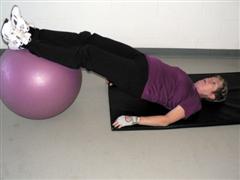Swiss Ball Wall Squat
Muscles involved: hip, knee and spinal extensors
Form: stand with Swiss ball near the small of your back in a comfortable position, against the wall. Stand with feet shoulder width apart. You may use your arms out to the front to help balance you. Brace the core, inhale, drop into squat position, aiming for your upper thighs to be almost parallel to the floor and a 90? angle at the hip. Drive your weight through your heels as you exhale and return to start position.
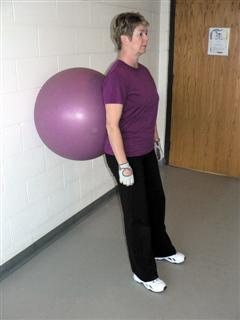
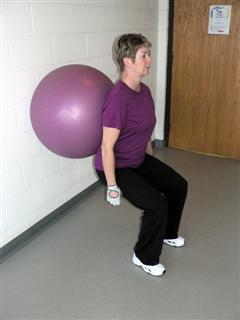
Cautions: keep knees from extending over the toes
Trainer techniques:
Cue breathing, contractions in gluteals and quads, watch for proper position of the spine and pelvis, and observe the motion at the hip, knee and ankles. Spot with your hands under the rib cage.
Side Lateral Lunge
Muscles involved: hip and knee extensors, hip abductors, deltoids
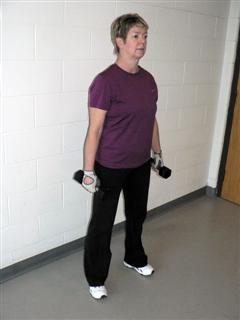
Form: stand with feet hip width apart, holding DBs. Step one leg out to the side,knees bent into a squat position, raising the DB in a lateral raise for the deltoids. Push off with the heel on that leg and return to central position, and switch legs.
Cautions: Do only the side lateral lunge without the deltoid raise if the client can’t do the raise. Pick an appropriate lighter weight for this raise.
Trainer techniques: Cue breathing, contractions in gluteals and quads, watch for proper position of the spine, pelvis, and arms, and observe the motion at the hip, knee and ankles. Spot with your hands under the rib cage.
Reverse lunge,standing
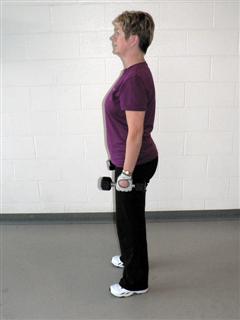
Reverse lunge, lunged position
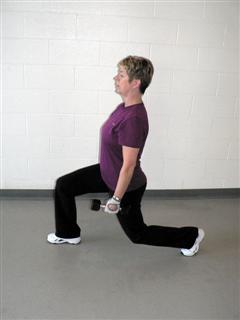
Muscles involved: hip and knee extensors, hip abductors
Form: stand with feet shoulder width apart, holding DB, MB, or body bar if you want. Brace core, and inhaling, take lead leg behind you and drop into a lunge position, keeping front leg knee behind the toes, and not allowing the rear leg knee to hit the floor. Drive your weight through the front heel, exhale and return to start; switch legs or do all on one side before switching.
Cautions: Keep the spine aligned properly, no spinal flexion or arching. Keep knee from extending over toes.
Trainer techniques: Cue breathing, braced core, contractions in gluteals and quads, watch for proper position of the spine and pelvis, and observe the motion at the hip, knee and ankles. Spot with your hands under the rib cage
Previous article: Side Lateral Lunge
Next article: Medicine Ball Squat
Medicine Ball Squat
Muscles involved: hip, knee and spinal extensors
Form: stand with feet hip width apart, holding a Medicine Ball Squat Position 1in front of your chest. Brace core, inhale as you squat down, aiming for your upper thighs to be almost parallel to the ground and a 90˚ angle at the hip. Drive your weight through your heels as you exhale and return to start position.
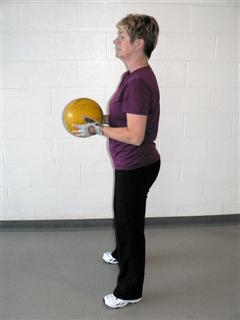
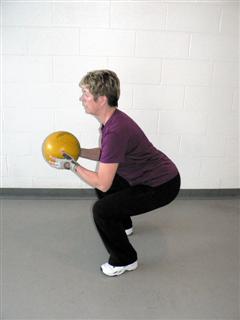
Cautions: keep knees from extending over the toes. Choose a lightweight medicine ball or a small dumbbell- if a heavy medicine ball is too heavy to hold.
Trainer techniques: Cue breathing, contractions in gluteals and quads, watch for proper position of the spine and pelvis, and observe the motion at the hip, knee and ankles. Spot with your hands under the rib cage.
Dumbbell Squat
Muscles involved: hip, knee and spinal extensors
Form: Stand with feet hip width apart, holding a DB in each hand. Brace core, inhale as you squat down, aiming for your upper thighs to be almost parallel to the ground, and a 90 degree angle at the hip. Drive your weight through your heels as you exhale and return to start position.
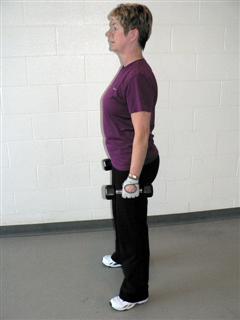
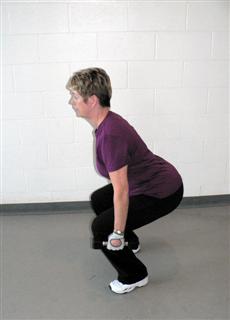
Caution: keep knees from extending over the toes
Trainer techniques: Cue breathing, contractions in gluteals and quads, watch for proper position of the spine and pelvis, and observe the motion at the hip, knee and ankles. Spot with your hands under the rib cage.
Previous article: Dumbbell Seated Shoulder Press
Next article: Deadlift
Dumbbell Seated Shoulder Press
Muscles involved: deltoids, triceps, pectorals, trapezius
Form: sit on bench, hips and knees flexed to 90˚, braced core, DBs in hands, flex elbows to 90˚, upper arms parallel to floor, palms facing outward. Inhale, and then exhale as you push the DBs straight up overhead, directly over the shoulders. Lower to start position.
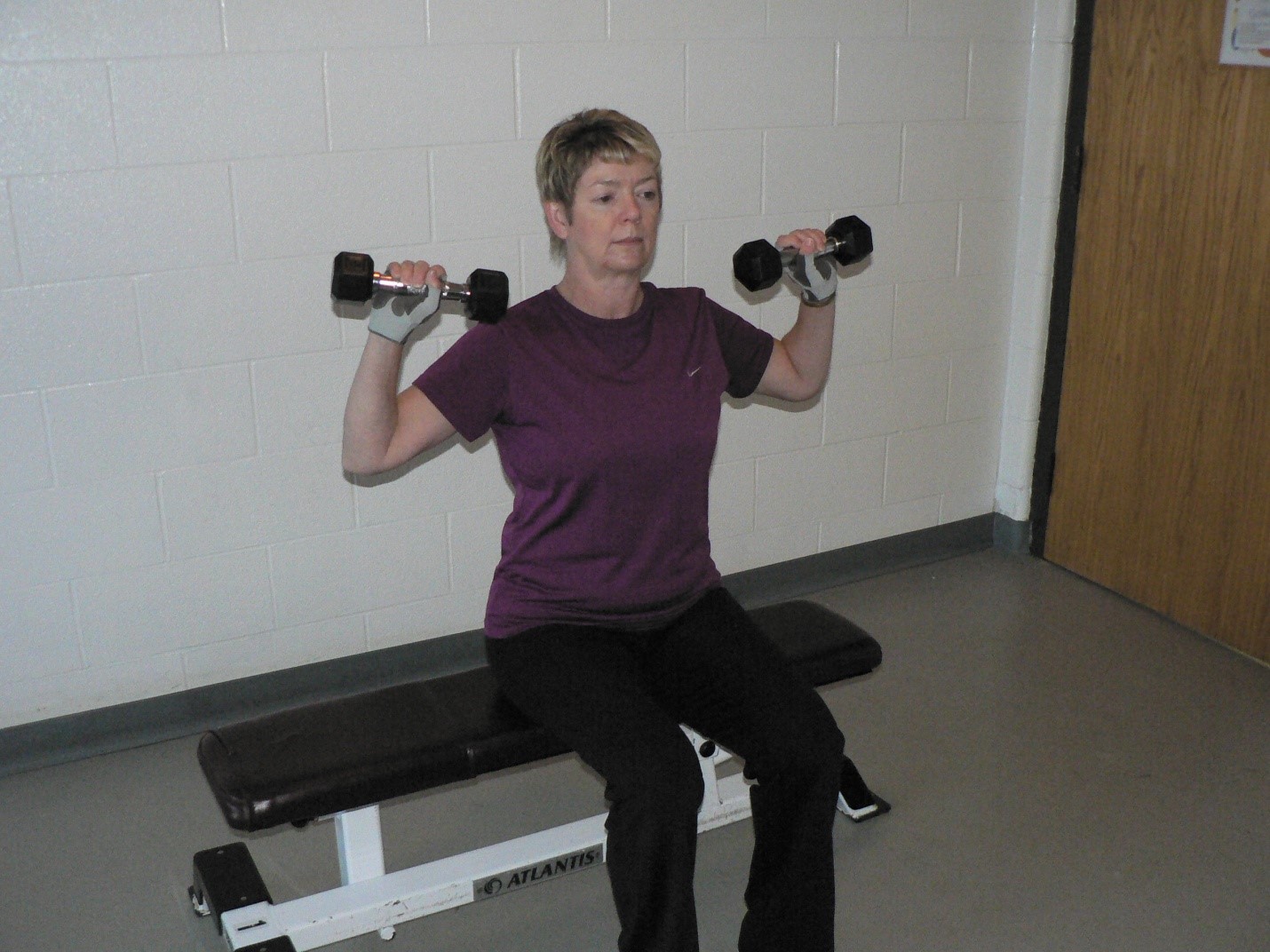
Cautions: ensure a braced core, good grip on the DBs. This exercise may be contraindicated for people with hypertension or shoulder injuries, and other exercises such as DB supine chest press or front shoulder raises may be substituted.
Trainer techniques:
make sure there is a natural curve in the lumbar spine, cue the anterior delts and pectorals, and breathing. Assess the positions of the spine and pelvis, scapulae, and the elbow movement. Spot with your hands under the client’s elbows, or at his wrists.
Previous article: Medicine Ball Squat
Next article: Dumbell Squat
Deadlift
Muscles involved: hip, knee and spinal extensors
Cautions:
Keep knees from extending over toes. Choose an appropriate weight to protect the lumbar spine.
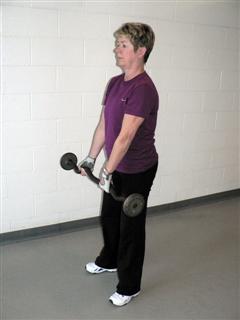
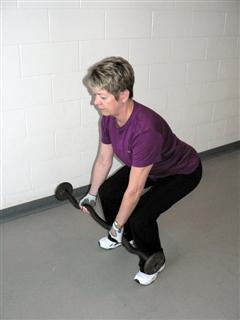
Form: start with feet hip width apart, a barbell held with alternating grip, start in squat position with flexion at hips, knees, and ankles, aiming for a 90 degree angle at the hip, and keeping the knees from extending over the toes. Brace core, breathe in, slowly come up out of the squat position to standing as you exhale.
Trainer techniques: cue breathing, contractions in gluteals and quads, watch for proper position of the spine and pelvis, and observe the motion at the hip, knee and ankles. Spot with your hands under the rib cage.
Previous article: Dumbell Squat
Next article: Barbell Hip Extension
Barbell Hip Extension
Muscles involved: hip, knee and spinal extensors
Form: Stand with feet hip width apart, braced core, barbell at feet. Squat to pick up the barbell, with an alternate grip. In a standing position, slowly lower the barbell close to the front of the thighs, elongating the hamstrings, keeping knees slightly bent. Do not lower past the point of comfort.
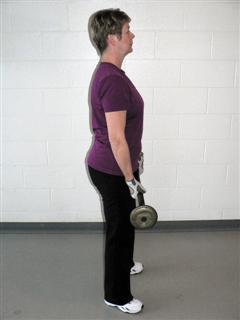
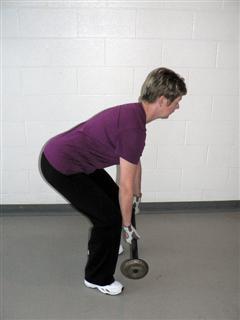
Cautions:
Make sure core is braced. Use DBs for this exercise if barbell is too much weight, or have a beginner do movement without weight. Make sure knees stay slightly flexed.
Trainer techniques:
cue breathing, watch for proper position of the spine and pelvis, and observe the motion at the hip, knee and ankles. Spot with your hands under the rib cage.
Barbell Bench Press
Muscles involved: pectorals, triceps, deltoids
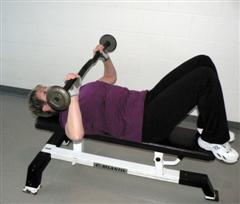
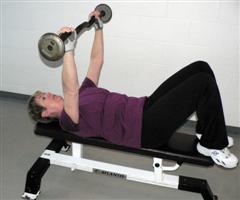
Form: lie supine on bench, head, neck and spine in a neutral position, start position is holding the barbell
over the chest with the elbows flexed to 90 ̊. Inhale, then exhale as you push the barbell straight up,
straightening the arms.
Cautions: keep core tight, wrists straight, barbell centred over the chest. This can be done with light dumbbells, feet may
be put up on bench if the client has lower back problems.
Trainer techniques: cue breathing, braced core, watch for proper position of the arms/elbows, dumbbells
centred. Spot with hands on the barbell.
Alternating Forward Lunge
<
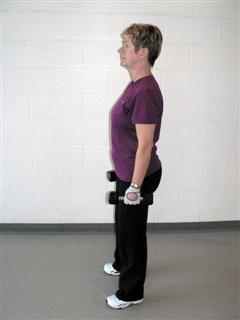
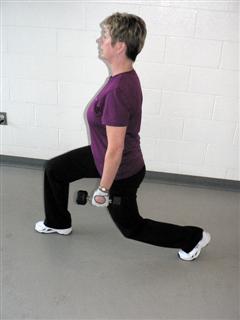
Muscles involved: hip and knee extensors
Form: stand with feet shoulder width apart, holding DBs if desired. Brace core, and inhaling, lunge one leg forward, dropping back knee downward, aiming for a 90 ̊ angle at the hip, and keeping the knee from extending over the toes. Press through the front heel, exhale, and come back up. Perform with the other leg.
Cautions: Keep the spine aligned properly, no spinal flexion or arching. Keep knee from extending over toes.
Trainer techniques: Cue breathing, contractions in gluteals and quads, watch for proper position of the spine and pelvis, and observe the motion at the hip, knee and ankles. Spot with your hands under the rib cage.
Alternating Dumbbell Bench Press
Muscles involved: pectorals, triceps, deltoids
Form: lie supine on bench, head, neck and spine in a neutral position, start position is holding the DBs
(dumbbells) over the chest with the arms straight, palms facing feet. Inhale and drop one DB with the
elbow flexed to 90 degrees, then exhale as you push the DB straight up, straightening the arm. Alternate.
Cautions: keep core tight, wrists straight, dumbbells centred over the chest. This can be done with light dumbbells or
tubing/bands, feet may be put up on bench if the client has lower back problems.
Trainer techniques: cue breathing, braced core, watch for proper position of the arms/elbows, dumbbells
centred. Spot with hands close to the dumbbells.
Start Position
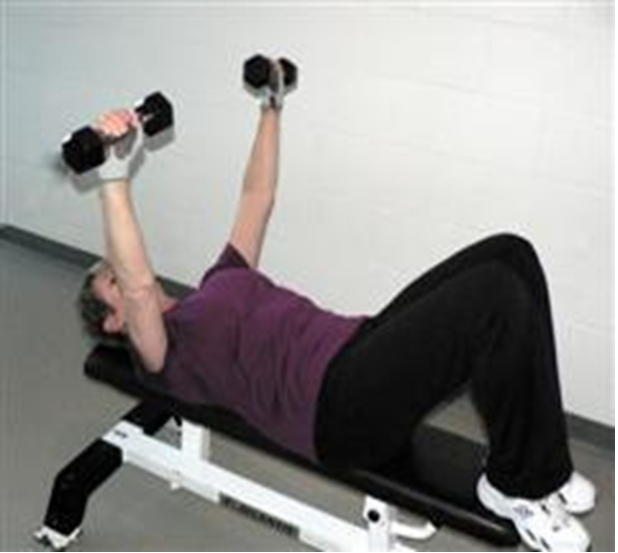
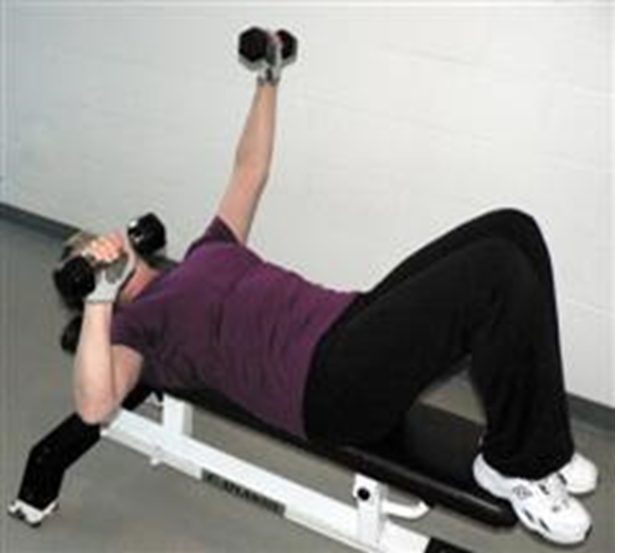
Previous article: Alternating Forward Lunge
Standing Hamstring Flexion
Muscles involved: hamstrings posterior oblique subsystem
Form: stand, feet hip width apart, facing cable wall, with attachment clip at the bottom, cuff around one ankle. Brace yourself at the cable wall, shift weight to other leg (which has a slight bend in the knee), brace core, maintain straight back. Breathe in, and exhale as you slowly pull up the cuffed leg, heel towards gluteals, to 90˚ knee flexion, pause, slowly return foot to ground.
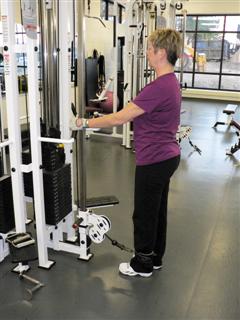
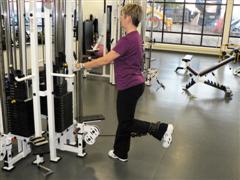
Cautions: tubing may be used if cable weights are too heavy. A seated position is also possible.
Trainer techniques: cue breathing, cue tall posture with well-aligned spine, and look for motion at the knee. To spot, stand to the client’s side and monitor the angle of flexion and posture throughout.
Swiss Ball Bridge Hamstring Curl
Muscles involved: hamstrings, gluteals, posterior core
Swiss Ball Hamstring Curl Position 2
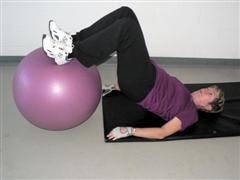
Form: lie supine on the floor, with legs straight and feet on ball, and hips elevated into bridge position. Inhale, and exhale as you pull feet/ball towards gluteals, staying in the bridge position. Return and repeat.
Cautions: Make sure client doesn’t put pressure on his neck, but rather on the shoulders/upper back. Beginners can do this starting and returning to back flat on the floor and then going into bridge.
Trainer techniques: cue breathing, watch for proper position of the spine, pelvis and upper back, and observe the knee flexion. Spot at the client’s side.
